Listing sponsored by
KappaElastin™
Scientific
Breakthrough.
No Shots
Science response to skin aging.
www.kappaelastin.com
Archaeology Rare Books
Getty Center, the
1200 Getty Center Drive
Los Angeles, California
Phone: 310 440-7360
TTY: (310) 440-7305
Statement of Purpose:
The Getty is an international cultural and philanthropic
institution devoted
to the visual arts and the humanities that includes an art museum
as well
as programs for education, scholarship, and conservation.
The Getty Center opened to the public in December 1997, unites the
J. Paul
Getty Trust's museum, institutes, and grant program on one site in
Los Angeles.
It has received well over one million visitors per year.
Situated in the Santa Monica Mountains off the 405 freeway in the
historic
Sepulveda Pass, the campus, designed by American architect Richard
Meier,
consists of six low-lying buildings on 110 acres.
The Getty Center features a new J. Paul Getty Museum, distinctive
buildings
housing the Getty Research Institute for the History of Art and
the Humanities,
the Getty Conservation Institute, the Getty Education Institute
for the Arts,
the Getty Information Institute, and the Getty Grant Program, and
the Central
Garden designed by artist Robert Irwin.
Located near the San Diego Freeway (interstate 405) and the Santa
Monica
Freeway (interstate 10) in Los Angeles, the Getty Center is the
new home
of the J. Paul Getty Trust, a foundation devoted to the visual
arts and the
humanities. The main public destination on the six-building campus
is the
new J. Paul Getty Museum which features European paintings,
drawings, illuminated
manuscripts, sculpture, decorative arts, and American and European
photographs,
changing exhibitions, and a wide range of programs for visitors of
every
age to enjoy, including gallery talks, lectures, film screenings,
concerts,
and family activities--most offered in both English and Spanish.
The Getty
Research Institute Library at the Getty Center is a resource for
scholars,
college and university faculty, graduate students, curators, and
independent
researchers.
The Getty Center experience includes breathtaking views of Los
Angeles, the
Santa Monica Mountains, and the Pacific Ocean, a choice of places
to snack
and dine, extensive gardens, and programs sponsored by all the
Getty
organizations which, in addition to the Museum, include the Getty
Research
Institute for the History of Art and the Humanities, the Getty
Conservation
Institute, the Getty Information Institute, the Getty Education
Institute
for the Arts, and the Getty Grant Program.
"We are building the Getty Center to be a cultural resource for
the city of Los Angeles," said Harold M. Williams, former
president and chief executive officer of the J. Paul Getty Trust.
"We hope that its visibility from many parts of the city will
serve as a magnet for visitors and as a reminder of the vital role
the arts can play in our lives. We intend for it to attract and
serve a broad public--people from Los Angeles and from around the
world, young and old, who will come there to enjoy and study art
and cultural heritage in an inspiring and stimulating setting."
http://www.getty.edu/
Highlights & Collections:
Getty Center visitors park in a 1,200-space structure and ascend
the hill
in an electric tram for the five-minute ride to the central plaza.
An inviting
staircase there leads them into the Museum and other parts of the
campus,
which features a full-service restaurant, two cafes, a Museum
bookstore,
and an auditorium seating 450, as well as the Research Institute's
exhibition
space, resource collections, and a reading area within the 750,000
volume
library.
Gardens and terraces throughout provide sweeping views of Los
Angeles, the
mountains, and the ocean.
The gallery space of the new J. Paul Getty Museum at the Getty
Center is
more than twice that of the present Museum in Malibu. Five
two-story Pavilions,
interconnected around an open central courtyard, house changing
exhibitions
and the expanding permanent collections of pre-20th-century
European paintings,
drawings, illuminated manuscripts, sculpture, and decorative arts,
and 19th-
and 20th-century American and European photographs.
Paintings are seen in galleries with natural skylights and
visitors are free
to see works of art chronologically or to enter individual
Pavilions through
the courtyard in any sequence they wish. Special viewing hours for
school
children and their teachers, lively family programs, and
interactive media
are some aspects of the educational programming. Visitors can also
attend
gallery talks, lectures, films, concerts, and art demonstrations
sponsored
by the Museum and the other Getty organizations.
J. Paul Getty Museum Timeline
- 1954 : J. Paul Getty Museum opens to the public in Getty's
home in Malibu. Getty's collections of antiquities, French
decorative arts, and paintings are on view.
- 1974 : The newly-constructed Villa opens on same grounds as
the second home of the J. Paul Getty Museum.
- 1976 : Death of J. Paul Getty. Getty oil stock worth $700
million left to Museum. Lawsuits prevent distribution to Trust
until 1982.
- 1983 : Land acquired in Los Angeles for new Getty Center.
- 1989 : Ground is broken at the site of the new Getty Center.
- 1996 : First office buildings at the Center completed and
occupied, by Conservation Institute, Information Institute,
Grant Program, and Trust.
- July 6, 1997 : Museum at Malibu to close.
- December 1997 : New J. Paul Getty Museum at the Getty Center
to open to the public.
- 2001 : Projected re-opening of the Villa as a branch of the
J. Paul Getty Museum and collaboration venture of Getty Trust
for study, conservation training, and education in ancient art
and comparative archaeology.
THE FUTURE FOR THE ANTIQUITIES COLLECTION
- Department of Antiquities
- Marion True, Curator of Antiquities and Assistant Director for
Villa Planning
All of the Museum's collections will move to the new Museum at the
Getty
Center in Los Angeles with the exception of antiquities. The Villa
in Malibu,
which closes in July this year, will re-open in the year 2001 with
the
antiquities on view as part of a new center for comparative
archaeology and
cultures. The period of closure will be used for renovation of the
building
in order to meet safety and access codes and to reflect the Roman
origins
of the Villa more accurately.
"When J. Paul Getty decided to re-create an ancient villa to serve
as the
Museum, he did so because it seemed most appropriate for the Greek
and Roman
art collection to be displayed in the kind of building in which it
might
originally have been seen," said Dr. True. "It is our hope that
the new,
expanded mission for the Villa, which unites the exhibition of
works of art
with research and conservation activities, will serve to enhance
his original
vision."
Antiquities were at the heart of the original collection formed by
J. Paul
Getty. His first purchase of classical art was a small terracotta
sculpture
bought at auction in 1939. By the time of Mr. Getty's death in
1976, the
collection of ancient Greek and Roman art was one of the most
important of
its kind in the United States. The collection has grown steadily
in the past
decade as plans for the new Museum and renovated Villa have
progressed. Examples
of sculpture--always a great feature of the collection--have been
further
strengthened, while the holdings of ancient Greek and Italian
vases have
grown to become the most significant feature. The collection's
scope has
been extended to include fine examples of Egyptian portrait
painting and
cast bronze portraits from the Roman Empire. An already important
collection
has been made even more so by the addition of about two hundred
extraordinary
and important works from the collection of Barbara and Lawrence
Fleischman,
part donation and part purchase, in 1996.
Antiquities will not entirely disappear from view during the years
of the
Villa renovation. Some will form the major part of the first
exhibition at
the new Museum at the Getty Center, provisionally titled The
Classical Legacy:
Art as Artifact, which is a collaborative exhibition between
several Getty
entities, inviting visitors to explore antiquity through the eyes
of
archaeologists and researchers, and giving a preview of the Villa
as it will
be after reopening. From 1999 onward a selection of objects from
the collection
will periodically go on view in the new Museum at the Getty
Center.
Many ancient sculptures were purchased by Mr. Getty, and remain
among the
most important items in the collection. These include a portrait
head of
Alexander the Great made at the end of the fourth century BC, a
group of
terracotta figures showing a musician and sirens, made in the
early fourth
century BC, and the Lansdowne Heracles, of about A.D. 125. Among
major
acquisitions made since Mr. Getty's death are the Victorious
Athlete, a Greek
bronze statue of the late fourth century BC, and a number of early
Cycladic
marble sculptures. One of the greatest purchases was the Walter
and Molly
Bareiss collection of Greek and Italian vases.
MASTERPIECES of PAINTING TO BE DISPLAYED IN NATURAL LIGHT
- Department of Paintings
- David Jaffe', Curator
The objective of this department over the past dozen years has
been to collect
the finest available European paintings from the 14th century to
the end
of the l9th century, including important works by the French
Impressionists,
masters of the Dutch, Flemish, and French Schools, and fine
Italian Renaissance
and Baroque paintings. Among the recently acquired works are great
paintings
by Bernardo Daddi, Fra Bartolommeo, Pontormo, Monet, Renoir, and
Cezanne.
Large paintings that have been held in storage at Malibu will be
displayed
in spacious new galleries at the Getty Center. At last, visitors
will be
able to step back from these larger works and experience them the
way they
were meant to be seen. The 20 top-lit galleries, with their
advanced daylight
control system, will enable the paintings to be seen in the
natural light
in which they were painted. "We will be able to display 25 percent
more of
the collection than was possible in Malibu, and in an exceptional
lighting
environment," said David Jaffe, Curator of Paintings. "Our policy
has always
favored displaying paintings in the best possible condition, and
they will
sparkle in the new galleries."
Although J. Paul Getty did not consider himself a collector of
paintings,
during his lifetime he nonetheless created a collection that
represented
European painting from the 13th to the 19th century. When Jaffe
joined the
Museum as Curator of Paintings in 1994, this collection had
expanded
substantially. "Getty recognized that significant paintings were
difficult
and expensive to acquire," commented Jaffe, "and the Museurn has
not tried
to build an encyclopedic collection. We have been able to balance
it out
over the past decade or so to include important early paintings
and to strengthen
the Italian, French, and Dutch schools. It has been transformed
from a relatively
small personal holding to a moderately sized but choice collection
of fine
works."
The paintings collection includes European works of art in oil,
tempera and
pastel from the 13th century to the end of the 19th century.
Public imagination
has been especially captured by the French Impressionists,
including the
famous 'Irises ' by Van Gogh. The collection also includes
significant works
by Masaccio, Rubens, Titian, Veronese, Rembrandt, and other great
masters.
Among Mr. Getty's original collection are three important
portraits, one
by Van Dyck, one by Gainsborough and another by Rembrandt.
PLANNING TO REVEAL A "NEW" COLLECTION
- Department of Sculpture and Works of Art
- Peter Fusco, Curator
For over a decade, this department has been quietly acquiring a
remarkable
collection of European sculpture and artistic treasures that will
only be
fully revealed once the new Museum opens at the Getty Center. Less
than half
of the collection can be shown in Malibu. The eight sculpture
galleries in
the new Museum will allow much more of the collections to be shown
at one
time.
"We have kept a low profile while building this collection,"
explains Peter
Fusco, Curator of Sculpture and Works of Art, "but we never
intended to keep
these things secret, as they were always intended for display in
the new
Museum. Much has languished in storage at Malibu for lack of
space. In the
last twelve years we have been able to significantly augment the
original,
fairly modest collection."
The collection now contains some exceptional Renaissance bronzes,
ceramics,
and glass, as well as Baroque sculpture, Italian furniture from
the 16th-
to the mid-19th century, and objects in terracotta, gold, silver,
and other
precious metals. It includes important works by Antico, Cellini,
Giambologna,
Bernini, Houdon, Carpeaux, and de Vries, among many others.
The department has also been collecting authentic period pedestals
on which
to display sculpture. "This is an aspect of the collection and new
display
that I am very excited about," commented Fusco. "To see works
mounted on
marble pedestals of the same period is something you usually find
only in
the grand houses and palaces of Europe. It's a rare opportunity in
America."
The Department of Sculpture and Works of Art collects European
sculpture
from the Middle Ages to the end of the l 9th century. Its
collection of Northern
European decorative arts from prior to 1650 and from Southern
Europe from
1650 to 1900 complements the Museum 's holdings of 18th-century
French decorative
arts.
A DECADE of DRAWINGS
- Drawings Department
- Nicholas Turner, Curator
The Museum's collection of drawings by great masters has grown
rapidly in
the last ten years and now numbers about 500. Selections will go
on display
in changing exhibitions in the dramatically presented new gallery
at the
Getty Center, which is about twice the size of the display space
in Malibu.
The collection was begun in 1981, four years after Getty's death,
with the
purchase of a chalk drawing by Rembrandt. The fast growth of the
past decade
reflects the Museum's aim to build a representative historical
collection,
with emphasis on the most important and brilliant draftsmanship in
the Western
tradition.
Drawings are sensitive to light and therefore cannot be exhibited
continuously.
The carefully designed showcases, produced by Helmut Guenschel
Inc. of Baltimore
and Glasbau Hahn of Germany use fiber-optic lighting that allows
light to
be directed very specifically at acceptable levels. This planning
process,
along with the design of the new gallery, has taken several years,
developing
alongside the construction of the new Museum building and the
growth of the
collection.
Since Nicholas Turner's appointment as curator of this department
in 1994,
he has considerably strengthened the Museum's holdings of 16th-
and 17th-century
drawings, but also expanded the collection into the 18th and l9th
century.
He came to the Getty from the British Museum in London, where he
specialized
in Italian drawings, and more recently in French l9th-century
drawings.
Catalogues prepared by Turner are now standard works of reference
on the
great masters of the Renaissance and on some of the world's most
outstanding
drawing collections.
"Drawings have very precise requirements for the kind of
environment they
need, and the kind of lighting to which they can be subjected,"
said Turner.
"We are delighted with the conditions we will be able to create in
the new
gallery. The cases will meet a very tight specification to keep
the drawings
in good condition, but we think they are going to look splendid
too, allowing
flexible installations of many drawings at a time. From our point
of view,
the really exciting prospect is being able to show more material
and to draw
out items from the collection to illustrate particular themes and
ideas.
We are planning exhibitions that will show the very best of the
collection,
but also ones that will explore interesting subjects needing space
that we
simply have not had before."
Past years have seen the acquisition of works by Raphael, Durer,
Bernini,
Rubens, Veronese, Poussin, Ingres, David, and Cezanne. Perhaps the
most notable
work in the collection is a drawing of the Holy Family by
Michelangelo. "This
is a subject that was very important to Michelangelo," explains
Turner. "He
returned to the theme of the Madonna and Child, or the Holy Family
again
and again. This is a great drawing, giving us real insights into
the way
the artist worked. Drawings of this quality need to be seen under
the best
possible conditions, and that is exactly what we are aiming for."
The drawings collection ranges from the second half of the 15th
century through
the end of the 19th century. It includes works executed in pen and
ink, charcoal,
watercolor and other media. Great artists of the past have used
drawing to
explore and develop ideas, and as a preparation for major
projects. Among
the more popular pieces in the Museum 's collection are a highly
finished
study of a stag beetle by Durer; sketches of a child with a lamb
by Leonardo
da Vinci; and a portrait of the Postman Roulin by Vincent Van
Gogh.
A GREAT FURNITURE COLLECTION BEING PREPARED FOR DRAMATIC NEW
DISPLAY
- Decorative Arts Department
- Gillian Wilson, Curator
Lack of gallery space has prevented the Museum at Malibu from
showing many
works in this outstanding collection. Known mainly for its
exquisite French
late 17th-and 18th-century furniture including several important
pieces by
the great cabinetmaker Andre-Charles Boulle, it includes silver,
ceramics,
tapestries, and carpets. The collection will fill fifteen
galleries in the
new Museum at the Getty Center where it will be displayed to much
greater
advantage. Some items will be on view for the first time.
Preparing objects for the new galleries has required delicate
conservation
work. Meticulous attention to detail over many years has gone into
planning
the layout and proportion of the new galleries, together with the
choice
of finishes and colors.
Gillian Wilson has been curator of the department since 1971, when
she was
hired by J. Paul Getty, the founder of the Museum, late in his
life as he
began to extend the collection more vigorously. In those days,
there were
about 30 objects. Today there are over 400. Few curators have had
the opportunity
to build a collection so rapidly, or be involved in the building
of first
one museum--the Villa at Malibu--then another, the new Getty
Museum at the
Getty Center. "I am particularly proud of our holdings of
furniture made
in Paris from the 1670s to 1720s," says Wilson. "These include
some of the
finest examples in the world of French furniture made in the
reigns of Louis
XIV and Louis XV."
Preparation for installation has included conservation, in Paris
and Malibu,
of four 18th-century paneled rooms, two of which have never been
on public
display. Along with the furniture will be tapestries, many in a
rare state
of preservation; beautiful chandeliers; wood and bronze worked
with remarkable
craftsmanship; and fine ceramics with many historical
associations. Works
being prepared for display include one 24-foot-long tapestry that
has not
been exhibited for many years.
Since 1987, the department has worked closely with the Office of
Thierry
Despont, the New York based firm that has been responsible for the
interior
architecture and design of these galleries as well as for the
finishes used
elsewhere in the Museum. Plans to line seven of the 15 rooms with
French
silks specially woven from traditional damask patterns have
involved detailed
collaboration with French companies which themselves have records
dating
to the 18th century. Together with other decorative and
architectural details,
these fabrics will help to create a suitable ambiance for the
display. Among
the works to be seen for the first time is a series of six large
tapestries,
glowing with color, showing the History of the Emperor of China,
made for
the second son of Louis XIV.
"The collection required surroundings of suitable scale and
decoration, closely
tied to the interior architecture of the period and using the
correct colors,
textures, and details," explains Wilson. "The new galleries will
be a museum
within a museum."
J. Paul Getty began to acquire furniture in the late 1930s and
continued
to acquire slowly until the 1960s. When he opened the original
small museum
in his home in Malibu, the entire collection of decorative arts,
consisting
of about thirty objects was housed in two galleries. Soon he began
to plan
a bigger museum.
With the prospect of opening the Villa in 1974, Mr. Getty began to
acquire
more vigorously in the early 1970s to his death in 1976. In this
period strong
roots were put down, and the conception began to be realized
forming a
representative collection of French decorative arts from the reign
of Louis
XIV (16431715) through the end of the reign of Louis XVI
(1774-1792).
PREPARING TO DISPLAY THE BEST of THE MANUSCRIPTS COLLECTION
- Department of Manuscripts
- Thomas Kren, Curator
Despite their important place in the history of European art,
illuminated
manuscripts (books written and decorated entirely by hand) have
not found
their way into many American art museums. The Getty Museum is
therefore
exceptional in holding an important collection of illuminated
manuscripts
of the Middle Ages and Renaissance which it displays in rotating
exhibitions
year-round. At the opening of the Getty Center, about 45 of the
Museum's
most splendid examples will be on view.
Thomas Kren, Curator of Manuscripts since 1984, played a major
role in the
research and deliberation that led to the Museum's acquisition in
1983 of
the collection of more than 100 illuminated manuscripts assembled
by Peter
and Irene Ludwig. The Museum's collection has continued to grow in
size and
importance, with more than 60 subsequent acquisitions. It presents
the history
of manuscript illumination from the 10th to the 1 6th century in
Western
Europe and the Eastern Mediterranean. Recent acquisitions include
an outstanding
early 16th-century manuscript illuminated by the Boucicaut Master,
which
will go on public display for the first time at the Getty Center.
"We mount four exhibitions of about 20 manuscripts from the
permanent collection
each year," said Kren. "Some focus on a particularly important
manuscript
in the collection, while others are arranged around historical
themes. We
endeavor in each exhibition to offer a glimpse of the art and
culture of
the Middle Ages and Renaissance, while also ensuring continued
variety for
our return visitors." Past exhibitions have provided new
perspectives on
the art of the great illuminator and panel painter Jean Fouquet,
the relationship
of art and science in the Renaissance, and the book arts of the
Persian capital
of Isfahan.
Several years of research and planning lie behind the presentation
in the
new Museum. Most important in this regard are the specially
designed display
cases with fiber-optic lighting that are now being fabricated by
Helmut Guenschel
Inc. of Baltimore and Glasbau Hahn of Germany.
Manuscripts, or handwritten books, were the primary vehicles for
the written
word from the centuries after the death of Christ through the
tenth century.
During this era illustrated books, called illuminated manuscripts,
were a
major art form. The types of texts illuminated include liturgical
and devotional
books, scripture, theology, law, philosophy and literature. The
Museum 's
collection includes masterpieces of the Middle Ages and
Renaissance, made
in Germany, France, Belgium, Spain, Italy, England, Poland, and
the Eastern
Mediterranean. Past exhibitions have won praise for showing new
perspectives
on subjects such as Alexander the Great and the Art of Isfahan.
A SPECTACULAR COLLECTION of PHOTOGRAPHS TO BE FEATURED
- The Department of Photographs
- Weston Naef, Curator
The growth and broadening of the Getty's collection of photographs
is perhaps
the most spectacular of all the developments at the Museum since
1984. It
was started in that year with the acquisition of several
exceptional private
collections that immediately established the Museum as a world
center for
photography. "If our entire collection of some 60,000 photographs
could be
exhibited at one time, we would need 30 miles of wall space,"
quipped Weston
Naef, Curator of Photographs. "Fortunately, we-prefer the
strengths of our
collection distilled like cognac into small rotating exhibitions,
with the
very best by the great individual photographers carefully selected
to communicate
their genius and to whet visitors' appetites for more."
The quality of the collection is widely acknowledged. Picture for
picture,
it may be the finest comprehensive collection in the world,
containing extensive
holdings of all periods, styles, and important makers before 1960,
each built
up by demanding collectors. Weston Naefjoined the staff of the
Museum upon
the formation of the collection in 1984. Under his guidance, the
department
has concentrated upon acquiring bodies of work by the finest
individual masters,
spanning the period in the 1830s immediately following the birth
of photography
through the 1960s.
In three photographs galleries in the new Museum, much more of the
collection
can be shown at any one time. The design of these galleries and
their lighting
has been lengthy and painstaking, as has the process of creating
galleries
for other works of art on paper. The department will continue its
tradition
of medium-sized exhibitions focusing on particular themes or on
the work
of individual artists such as Julia Margaret Cameron, Alfred
Stieglitz, Doris
Ullman, Carleton Watkins, Edmund Teske, and Frederick Sommer,
among others.
Time Not in Motion, the first exhibition to be mounted by the
department
at the Getty Center, will explore the theme of time--whether
captured or
remembered--in l9th and 20th-century photographs.
Photographic exhibitions are among the most popular to be
presented by the
Museum. This is the only part of the collection to encompass
American art
and extend into the 20th century. The Museum decided to collect in
this area
in the early 1980s for the same reason it decided to collect
drawings and
manuscripts: it saw photography as an art fundamental to its time
in which
individual works of great rarity, beauty and historical importance
have been
made. The collection contains work by many of the great American
and European
photographers, from the early achievement in the 1830s by William
Henry Fox
Talbot to those of the modern masters, including Andre Kertesz and
Walker
Evans.
A MAJOR COMMITMENT TO EDUCATION
- Diane Brigham, Head of Education
For the past five years, in keeping with the Museum's philosophy
and in
preparation for the move to the Getty Center, the J. Paul Getty
Museum Education
department has evolved into one of the largest art museum
education divisions
in the country and the biggest department within the Museum. It
has a staff
of more than 30 people working with the Los Angeles community to
help demystify
the experience of the art museum and to reveal it as a friendly
and rewarding
place for a broad audience to visit.
"Because our mission is to serve the widest possible audience,"
said Diane
Brigham, Head of Education, "we've focused on making the new
Museum accessible,
not just physically, but intellectually and emotionally. We
listened to what
visitors said they needed, and we are incorporating a variety of
points of
view in the interpretation of the collection and employing an
ever-growing
array of teaching approaches." Brigham and her staff have been
collaborating
with educators throughout Los Angeles in an effort that has ranged
from audience
focus groups in which visitors were asked to critique gallery
labels to
collaborative projects that help community members use the
resources of the
Museum more effectively.
"At the Museum in Malibu we are succeeding in gradually attracting
a wider
and more diverse audience," she said. "We plan to expand on this
success.
Future visitors will be greeted with an atmosphere of learning,
fun, and
curiosity. Our initiatives recognize that it takes a range of
voices and
approaches to explore art. Understanding the various perspectives
of the
experts, artists, and others who study, care for, and are inspired
by the
art can help our Museum come alive for visitors. Ultimately, we
want to help
visitors make their own connections with the art, relating it to
their own
lives and current social issues."
Improved programs and new services, now several years into
planning for the
new Museum, will include a random-access audio guide, architecture
and gallery
talks, concerts, evening events for college students, parent
workshops, family
festivals, multiple school visit programs, a teacher resource
room, and studio
facilities for arts activities. Four information centers adjacent
to the
galleries will offer hands-on activities, multi-media
presentations, and
demonstrations related to the nearby collections. Bilingual family
programs,
storytelling, and gallery game boxes will be expanded with the
addition of
the Family Room, a place where people with children can start
their visit
or join in the participatory activities. A project called "Make
the New Museum
Your Museum" has formed two pilot partnerships with after-school
centers.
This will challenge young students to think about the functions of
a museum
and the nature of the arts. Getty staff will conduct workshops,
both in the
community and in the Museum, that will train teachers how to use
museum
collections as an inspiration for their students not only to
create art but
to look, write, and talk about it.
The Museum 's audio guide is being developed with Antenna, a
California-based,
nonprofit arts organization. It will use CD-ROM technology, giving
visitors
many options in designing their own guided tour through the
galleries, and
will be available in English and Spanish. The company has done
similar work
for the Vatican Museums, the American Museum of Natural History,
and the
San Francisco Museum of Modern Art. Partners of the J. Paul Getty
Museum
for the "Make the New Museum Your Museum " project from within Los
Angeles
include the USC Family of Five Schools Program, composed of the
Foshay Learning
Center, 32nd Street/USC Magnet, Vermont School, Norwood and Weemes
Elementary
Schools. The Museum is also working with the After School Activity
Program
which has 24 school and community sites in different parts of Los
Angeles.
Visiting the Getty Centerhttp://www.getty.edu/
Click the links below to view the latest news from
the Getty:
Getty Museum Acquires Important Painting by Rubens
and Brueghel in Honor of Retired Director John Walsh
Three New Getty Exhibitions Highlight Italy on the
Grand Tour
New Exhibition at the Getty Explores Books and
Reading
Quarterly News Bulletin and Exhibition Schedule
The Getty Center is open
- Tuesday and Wednesday, 11am-7pm;
- Thursday and Friday, 11am-9pm;
- Saturday and Sunday, l0am-6pm.
- It is closed Mondays and major holidays.
Admission to the Getty Center is free.
Parking is $5 per car. No parking reservations needed on
Saturdays and Sundays or after 4 p.m. on weekdays.
Visitors may also arrive by other means, such as public
transportation (MTA #561 and Santa Monica Big Blue Bus #14), taxi,
or local shuttles. For information and reservations, call
310-440-7300. The TTY line for callers who are deaf or hearing
impaired is 310-440-7305.
Click the link below to view the Getty's
News Bulletin:
http://www.getty.edu/news/
Images.
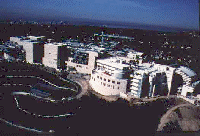
Aerial view of the Getty Center
Copyright: The J. Paul Getty Trust Photo: Warren Aerial
Photography, Inc. Architect: Richard Meier & Partners

Lansdowne Herakles
Unknown Roman sculptor, ca. A.D. 125 . Discovered near Hadrian's
Villa, Tivoli, ca. 1790 Pentelic Marble 76 3/16 in.
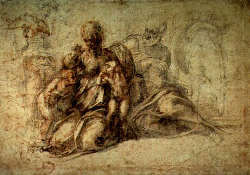
The Holy Family with the Infant Saint John the Baptist
ca. 1530 Michelangelo Buonarotti (Italian, 1475-1564) Black and
red chalk with pen and brown ink over stylus 11 X 15.5 in.

Irises
1889. Vincent van Gogh (Dutch, 1853-1890) ; Oil on canvas 28 X
36 5/8 in.
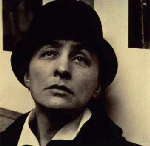
Georgia O'Keeffe: A Portrait
1923 Alfred Stieglitz (American, 1864-1946). Palladium print 7
1/8 X 7 1/4 in.

Cabinet on stand
Paris, about 1680. Attributed to Andre-Charles Boulle (French,
1642-1732). Oak veneered with tortoise shell, brass, pewter,
horn, ebony, ivory and with marquetry of stained and natural
woods; drawers of snake wood; figures of painted and gilded oak;
gilt-bronze mounts 7ft.6 1/2in. x 4ft. 11 1/2 in. x 2 ft 2/4 in.
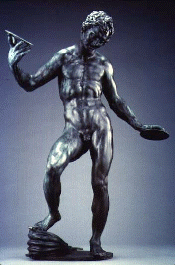
Juggling Man
ca. 1610-1615 Adriaen de Vries (Dutch, 1545-1626) Bronze H: 30
1/4 in.; W: 20 3/8 in.; D: 8 5/8 in.
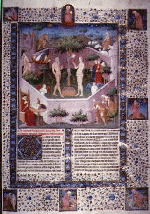
The Story of Adam and Eve
ca. 1415 Boucicaut Master (French, active ca. 1405-1420) and
workshop of Boucicaut Master from Boccaccio, "The Fates of
Illustrious Men and Women" (Des cas des nobles hommes et
femmes). Tempera and gold on vellum Leaf: 16 3/4 x 11 9/16 in.
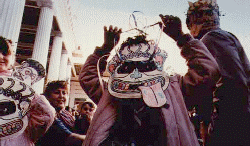
Art-making at a Getty Museum Family Day Festival
Copyright: The J. Paul Getty Trust. Photo: Robert Pacheco
Key Personnel:
Dr. Barry Munitz, President and C.E.O of the J. Paul Getty
Trust
- John Walsh, Director;
- Barbara Whitney, Associate Director;
- Deborah Gribbon, Associate Director;
- Marion True, Curator of Antiquities and Assistant Director
for Villa Planning;
- David Jaffe', Curator Department of Paintings;
- Peter Fusco, Curator Department of Sculpture and Works of Art
;
- Nicholas Turner, Curator Drawings Department ;
- Gillian Wilson, Curator Decorative Arts Department;
- Thomas Kren, Curator Department of Manuscripts;
- Weston Naef, Curator Department of Photographs;
- Diane Brigham, Head of Education;
- Susan Ann Ruynard, Head of Public Information & Visitors
Services
Tell us what you think.
Do you have any additional
comments
concerning this site?
Do you wish to receive some information on
how to get your museum
on the Museums Tour?
Thank you again for your visit.
This page and all contents are © 1995-2014 Art Emotion
Corp., IL. USA.
All information is subject to change - This document is non
contractual.








